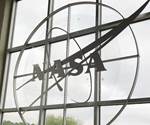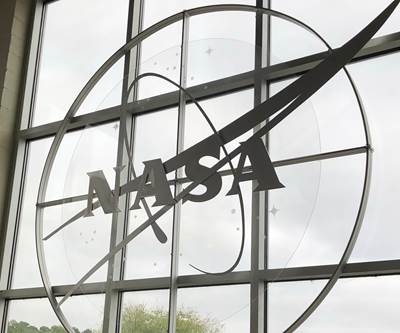Design for manufacturing, assembly and automation enables complex CFRP telescope supports
Airborne delivered two mirror support structures for the FYST and SOLAT telescopes, assembling 26,300 components while maintaining near-zero CTE, strict tolerances on 6.5 × 6.5 × 1.8-meter assemblies.
Rendering of the Fred Young Submillimeter Telescope (FYST). Source | CPI Vertex Antennentechnik GmbH
The Fred Young Submillimeter Telescope (FYST) is a 6-meter-diameter state-of-the-art telescope designed to operate at submillimeter to millimeter wavelengths for wide field observations and large-area surveys. These will include studies of the Milky Way galaxy’s magnetic structure, formation and fundamental physics as well as investigation into the formation of stars and galaxies, the birth of the first stars after the Big Bang, and the origin and development of the universe.
Developed by the CCAT partnership for more than two decades, its global set of partners includes Cornell University (Ithaca, N.Y., U.S.), a German consortium of the University of Cologne, the University of Bonn and the Max Planck Institute for Astrophysics in Garching, and the CATC consortium of 10 Canadian academic institutions. At the time this article was written, installation on the Cerro Chajnantor, a 5,600-meter-high mountain in the Atacama Desert of northern Chile, was to be completed by the end of 2024.
Submillimeter-wavelength astronomy is described as the last unexplored wavelength frontier due to the sheer complexity of the instrumentation and the “opaqueness” of the atmosphere in microwave light. The recent production of sensitive heterodyne receivers (a type of radio receiver) for astronomical purposes has opened this wavelength band for the first time. However, this combination of highly technical instrumentation and large physical size — the telescope spans 23 square meters of floor space and can house almost 20 tons of instruments — creates a need for lightweight yet strong, extremely stiff and thermally stable structures to hold its two massive mirrors.
Thus, FYST’s mirror support structures (MSS) are key to enable its research deep into the universe and, notably, are composite structures. Their design, production and assembly were achieved by Airborne (The Hague, Netherlands) in collaboration with client and prime contractor, CPI Vertex Antennentechnik (Duisberg, Germany). The project showcases a very technically challenging composites design and manufacturing case history, but the automated production processes and design for assembly techniques it required may provide the most important takeaways for future complex composite structures in space and on Earth.
Design
Unprecedented accuracy twice
Airborne had worked with CPI Vertex before, to develop the MSS for the Atacama large millimeter/submillimeter array (ALMA) in Chile and for the South Pole telescope (SPT) in Antarctica. “Both telescopes contributed to the first-ever image of a black hole in 2019,” says Sandor Woldendorp, business unit manager at Airborne. “While the ALMA telescopes were designed with a high mirror surface accuracy of 25 micrometers, the demands for the FYST were even more stringent.”
The FYST has an off-axis Crossed-Dragone design, comprising a parabolic primary mirror and a large concave secondary mirror, both roughly 6 meters in diameter. This creates a high-throughput, wide field of view telescope capable of mapping the sky very rapidly and efficiently. However, the complete system with two 6-meter-diameter mirrors has a surface error budget of just 10.7 micrometers during operation. “This has never before been achieved in this class of telescope,” says Jaap Dekker, composites expert and lead engineer at Airborne.
An additional challenge for CPI Vertex and Airborne is that production would be for two telescopes using the same design: the FYST and the Simons Observatory large aperture telescope (SOLAT). The MSS for the SOLAT and FYST are identical and both projects were executed in parallel.
Design challenges
Airborne’s task was to develop extremely stable, passive MSS that would be virtually unaffected by gravitational forces or changes in ambient temperature. The mirrors sit in a semi-enclosed housing, so they are protected yet exposed to outside temperatures which can range from -21°C to 9°C during observations. While this makes the design process for the MSS more challenging, the telescope is designed to be robust and reliable. “This is key to minimize the risk of breakdowns and necessary repairs at the top of a 5,600-meter mountain,” notes Dekker.
The MSS were designed using an advanced carbon fiber-reinforced polymer (CFRP) composite, he continues, because it achieves a near-zero coefficient of thermal expansion (CTE) with a very high stiffness to ensure that deformations are reduced to the absolute minimum. “We designed a hybrid structure that uses a thick CFRP/aluminum honeycomb sandwich top plate onto which the mirror segments are mounted,” adds Dekker. A 3D truss structure attached to this top plate provides the global stiffness and attachment points for the rest of the telescope structure. This 3D truss is composed of standard C-profiles made using monolithic CFRP laminates.”
Composite laminates, CTE, pitch fiber
Because FYST’s parabolic primary mirror and concave secondary mirror have different shapes, and sit within the telescope in a different position, they experience different loads and have their own unique designs. Using Ansys Inc. (Canonsburg, Pa., U.S.) finite element modeling (FEM) and an in-house developed optimization routine, CPI Vertex Antennentechnik optimized the cross-sectional area of each individual beam in the truss. “Our challenge was to design the actual truss structure to match these cross-sectional areas, while considering all the connections in the node points,” says Dekker. Airborne developed a preliminary design using analytical calculations to predict the properties of the beams, such as their stiffness, CTE and density. Using this, it could then continue with the detailed design, including 3D modeling all the details in Siemens NX (Plano, Texas, U.S.) CAD, detailing the node points and completing more FEM analyses, also performed using Ansys software.
“An integral part of the structural design was designing the composite material itself to meet the high specific stiffness and near-zero CTE required,” notes Dekker. But the latter also had to be as homogeneous as possible across the structure. “It was very challenging to predict and match the CTE of the sandwich top plates accurately enough with that of the truss structure due to the completely different structure types.
“It soon became clear that we couldn’t meet the high design requirements with regular high-strength carbon fiber, or even a single fiber type, so we designed a hybrid laminate structure using both high-strength and ultra-high modulus [UHM] pitch carbon fibers,” he continues. The latter have a stiffness that is three times higher than high-strength carbon fiber. “Thanks to this combination, the specific stiffness of the truss laminate (longitudinal stiffness divided by density) is about five times higher than the special low-CTE steel alloy Invar 36, yet the CTE is just 1/5th of Invar 36.”
Production
Exploiting automation for lowest composite manufacturing costs
Part of Airborne’s design strategy was to make the structural elements as large as possible to minimize the number of connections required during the assembly stage. “First, we maximized the dimensions of the top plate sandwich segments so that only four were needed per mirror,” says Dekker. “Second, the truss structures were designed with three subassemblies that run almost the entire length of the structure.”
These subassemblies are built up from two large “skin” laminates in the geometry of the truss, with standard C-profiles between them to provide bending stiffness. Although this design strategy results in a high-performance structure, laminating the composite structural elements for this project posed a significant challenge.
“The sheer scale was imposing,” says Woldendorp. “Each MSS weighs roughly 1,500 kilograms and comprises 5,000 square meters, or 33 kilometers, of unidirectional [UD] prepreg tape. The truss skins also have a very complex design and many of the components are so large, they are difficult to manufacture using hand layup.”
Another issue is that UHM pitch carbon fiber is very brittle, making it difficult to handle. “Unfortunately, there was no automated manufacturing process available in the market that was capable of manufacturing the complex truss skins,” Woldendorp adds. “So, we developed the automated manufacturing solution in-house.”
ALC performs automated tape laying (ATL, top), and pick and place truss skin blanks from a master laminate into truss geometries (center), enabling this set of net-shaped truss skins after laminating, ready for cure. Source | Airborne
Automated Laminating Cell
Airborne’s Automated Laminating Cell (ALC) combines automated tape laying (ATL) of the laminate, automatic cutting of the laminate into the required blanks, and then pick and place (P&P) for arranging the cut plies in the geometry of the truss skins. “The large laminates for the top plates were also laminated using the ALC,” says Dekker. “To our knowledge, this is the only system in the world capable of automatically laminating fragile pitch carbon fiber. We automated all the lamination, saving thousands of hours of manual labor, while ensuring a repeatable, high-quality process.”
The ALC Manager software platform enabled direct import of CAD data containing the geometry, material and lay-up details for the different components. Several components were sent simultaneously to the ALC Manager, which automatically generated a nesting pattern from the myriad different parts and blanks. The ALC then built the truss skins from tens to hundreds of individual cut blanks, using multiple laminate designs to achieve the desired stiffness in the structure. The software also automatically generated all robot movements and CNC code needed for ATL, cutting, and pick and place. This was a large benefit in that Airborne didn’t have to do any programming, which would have taken thousands of hours.
Net-shaped components
Airborne optimized its design so that almost all of the components are made net-shaped, minimizing subsequent CNC machining. This also saved thousands of hours of programming and machining and resulted in very low material waste. “Only the skins for the top plate had a small oversize for bonding,” says Dekker, “but those needed to be milled anyway because of holes required for the bushings where the adjusters of the mirror segments are mounted.”
Automated manufacturing of C-profiles
For the C-profiles, the ALC Manager created large nesting patterns from about 40 C-profiles at a time, which were laminated and cut into near-net shape blanks. “At this stage, all C-profile blanks received a unique identifying label,” says Dekker. “The blanks were hot drape formed using an in-house developed hot forming cell and cured in an oven (no over pressure just vacuum).”
As part of the design for assembly, all C-profiles had unique angles at their ends. “These were milled based on their identification and a parametric milling file,” says Dekker. “We only had to program the milling machine once to complete hundreds of different C-profiles.”
Strict control of fiber volume content
As explained above, Airborne designed the composite laminates using an exact ratio of high-strength and UHM pitch carbon fibers, as well as an exact ratio for each fiber to epoxy resin. Thus, it needed strict measures to control the amount of fibers and resin in the prepreg and also in the as-built laminates. “Our prepreg supplier Toray Advanced Composites [Langley Mill, U.K.] supported us by tuning its machinery to achieve the most stringent production tolerances possible and also put more checks and balances in place,” notes Dekker. Airborne then checked all incoming prepregs and material from different batches to ensure that the prepregs per laminate were within the specifications required.
“We also needed to maintain an exact resin-to-fiber ration in the final cured product,” says Dekker. “Normally, a lot of resin flows out of the laminate during the autoclave curing process. We addressed this through a customized curing method developed with Toray. Thus, it was possible for us to efficiently lay up and cure more than 400 individual C-profiles, with a total length of 1,200 meters, while achieving a CTE within strict boundaries and a dimensional tolerance of ±0.2 millimeter for the cross section.” This customized curing process was additionally used for all the other laminates, similarly to achieve the CTE within strict boundaries.
Assembly
The next step was to assemble these parts into MSS sections that could be transported to Germany for final assembly. “By using the design for manufacturing and assembly [DFM&A] approach, we were able to achieve significant cost savings in the manufacturing and assembly stages while still ensuring we met the extreme performance requirements,” says Woldendorp.
To give an idea of the complexity involved, each of the two MSS (M1 and M2) required assembly of ≈6,600 parts — ≈2,400 composite parts, of which ≈300 were uniquely laminated, using eight very different specialized adhesives. “We had to assemble both structures two times,” says Woldendorp, “once for the FYST telescope and once for the SOLAT telescope. Costs are always a major issue in projects of this complexity and scale. Thus, we needed a simple and low-cost assembly process that would still allow us to achieve a very accurate end result.”
Truss subassembly
Airborne started with a thorough tolerance study to investigate the required dimensional tolerances at the different assembly levels. “This also resulted in defining the nominal bond line thicknesses,” notes Dekker, “which was an important input for the design regarding the stiffness, mass distribution and thermal expansion analyses.”
An example of a complex node in a truss during the subassembly process, showing the the tool with pins. Source | Airborne
One result from this analysis was that specially designed tooling was required to achieve high assembly accuracies. However, this didn’t necessarily mean the tooling had to be costly. “The DFM&A approach we used allowed us to use a low-cost tooling concept to create the subassemblies of the trusses,” explains Dekker. “That concept used MDF [medium density fiberboard] wood panels with pins to accurately position all the elements of a truss. The MDF panels were machined using 2.5-axis milling, making it possible to achieve submillimeter assembly tolerances on subassemblies that were more than 6 × 1.7 meters. This concept allowed us to significantly reduce the CNC machining effort for the truss structure.”
Low-cost, high-precision truss assembly tools
The next challenge was assembling the trusses to each other with high precision. “To assemble the planar trusses together, we created a 7 × 7-meter flat assembly floor (flatness < 1.5 millimeters) from MDF panels in which we machined accurate positions for placing standardized vertical columns made from multiplex,” says Dekker. Multiplex is plywood made from glued wooden veneers. “These defined an accurate plane in 3D space to position each of the different trusses,” he continues. “The same assembly floor and columns could be reused for both M1 and M2.”
Thus, using the DFM&A approach, Airborne was able to use simple standardized elements from low-cost materials. “By relying on the accuracy of 2.5D CNC machining, simple tooling assembly steps and a flat floor, we were able to position the different trusses in a 7 × 7 × 1.7-meter box, to an accuracy of approximately ±1.0 millimeter,” says Dekker. “This enabled us to reach strict tolerances on the interface points to the rest of the telescope structure, and a good control of the bondline thicknesses.”
Top plate assembly
Bushings are assembled to a top plate segment. Source | Airborne
Truss-to-truss assembly is in progress on the flat assembly floor, showing the standardized tooling elements. Source | Airborne

The next challenge was how to assemble the large top plate from numerous sandwich panels — comprising aluminum honeycomb and CFRP skins — that measured roughly 6.5 × 1.8 -meters and 85 millimeters thick. “To allow for connections to other structural elements, while still achieving the performance requirements, these panels were fitted with an additional internal and circumferential reinforcement system,” says Dekker. “Again, by using the DFM&A approach, we were able to define relatively easy processes and assembly tools to create these complex subassemblies.”
Three specialized adhesive systems with elevated temperature cures were required to connect all the elements together. However, the assembled top plate segments have a near-zero CTE. “This made it impossible to use standard metal tools to position all the elements during cure,” explains Dekker, “because the shrinkage of the metal tooling during cooldown would crush the top plate which had no thermal expansion or shrinkage. To address this, we selected an adhesive to bond the internal and circumferential reinforcement system to the skins that partially cures at room temperature. This enabled us to use low-cost tooling at room temperature to accurately position and cure the elements together. Afterward, the product became its own tool for the final elevated cure cycle in the autoclave.”
Bushing assembly
To complete the top plate subassembly, Airborne had to assemble up to 126 bushings into each cored CFRP panel segment. These bushings — composite tubes that connected to both sandwich panel skins — would house the adjustment mechanisms for the mirror segments that would be mounted on the top plate.
The mirror, once assembled, was designed to have a double-curved surface with a ≈3 micrometer accuracy. “To achieve this, all the bushings needed to be assembled onto the top plate at a unique 3D angle and protrusion length, and with a fairly high positional accuracy between them,” says Dekker. “We were able to again use low-cost tooling but connecting the bushings to both the skins of each top plate segment was a significant challenge.”
“We knew early on that this connection could not be very rigid,” he continues, “because the composite bushings would tear the aluminum honeycomb core apart due to the difference in CTE during thermal loading. So, we designed complex 3D spring elements from a carbon fiber-reinforced thermoplastic material, injection molded by our neighbor company Promolding [The Hague, Netherlands]. By tuning the stiffness of these components, we could manage the stress levels in the aluminum honeycomb, while still providing enough stiffness for an effective adjustment of the mirror segments.”
Optimized assembly for transport
Due to the large size of the MSS, M1 and M2 could not be fully assembled before transport to Germany. Airborne’s solution was to assemble the structures in two halves, but this required strict alignment and positioning to achieve an accuracy of less than 0.5 millimeter. “We first assembled the top plate segments in sets of two to create the half top plates,” notes Dekker. “The challenge here was the large amounts of adhesive and strict position tolerance required, as well as a strict requirement for the flatness of the completed top plate to be able to bond it to half a truss. The DFM&A method enabled us to achieve this using simple processes and low-cost tooling and equipment.”
Final assembly
Each half MSS measures approximately 3.3 × 6.5 × 1.8 meters — just manageable enough to be transported by truck. Airborne completed the final assembly of the MSS in Germany at a facility close to where the the complete telescope assembly would be trialed. “Bonding these big structures together in one assembly step was difficult due to the extremely large bonding areas, the use of different adhesives and the strict tolerances,” notes Dekker. “The best solution was applying all of the adhesives at the same time, and then slowly and accurately moving the structures into position before letting the adhesives cure. As required, we got this right in one go and within submillimeter accuracy.”
CPI Vertex Antennentechnik then assembled and aligned the mirror segments to the MSS Airborne had delivered. While the MSS was not fitted in this trial assembly, all other major mechanical systems were trial assembled and tested. The FYST will be disassembled back into large components and transported to its final location in Chile, where it will undergo final assembly and commissioning for operation in 2025.
“Airborne’s big investment in the development of the ALC enabled us to do this project right the first-time right,” says Woldendorp. “Since the largest part of the production effort has been automated, we are now fully set up to build more MSS for other telescopes. But we have also developed a wide range of techniques, processes and capabilities that have value for other large composite structural assemblies.”
Related Content
A new era for ceramic matrix composites
CMC is expanding, with new fiber production in Europe, faster processes and higher temperature materials enabling applications for industry, hypersonics and New Space.
Read MoreJeep all-composite roof receivers achieve steel performance at low mass
Ultrashort carbon fiber/PPA replaces steel on rooftop brackets to hold Jeep soft tops, hardtops.
Read MoreCarbon fiber, bionic design achieve peak performance in race-ready production vehicle
Porsche worked with Action Composites to design and manufacture an innovative carbon fiber safety cage option to lightweight one of its series race vehicles, built in a one-shot compression molding process.
Read MoreManufacturing the MFFD thermoplastic composite fuselage
Demonstrator’s upper, lower shells and assembly prove materials and new processes for lighter, cheaper and more sustainable high-rate future aircraft.
Read MoreRead Next
Composites in the race to space
Advanced materials use in current and upcoming NASA missions.
Read MorePost Cure: CFRP landing leg supports reusable launcher capabilities
MT Aerospace AG, as part of the EU’s Horizon Europe project SALTO, has successfully developed a 7-meter-long carbon fiber-reinforced polymer (CFRP) landing leg demonstrator using advanced automated fiber placement and 3D printing technologies.
Read MoreNASA reveals James Webb Telescope’s first images of an unseen universe
The world gets its first look at the full capabilities of the composites-intensive James Webb Space Telescope in space through a series of highly detailed images.
Read More






























